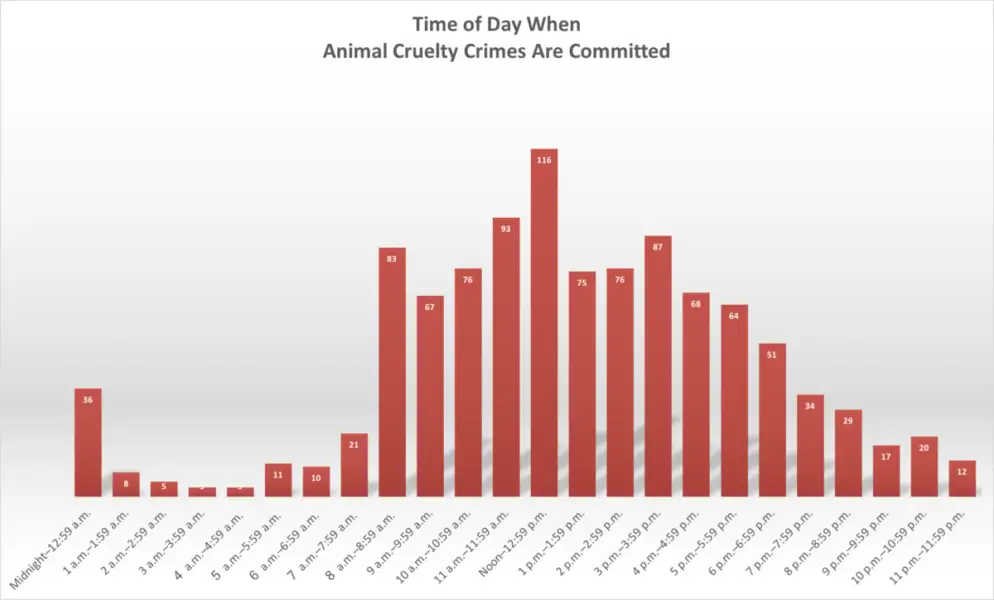As 2017 came to a close, we are getting the first glimpse of how the FBI tracks animal cruelty in their database.
As The Catnip Times reported back in 2015, the FBI began tracking animal cruelty in the FBI animal abuse registry, also known as NIBRS (National Incident-Based Reporting System) and the full year of data has been released. The FBI categorizes crimes in three ways: crimes against persons, crimes against property and crimes against society. The FBI considers animal cruelty a “Crime Against Society” with the following definition:
Crimes Against Society, e.g., gambling, prostitution, and drug violations, [including animal cruelty] represent society’s prohibition against engaging in certain types of activity; they are typically victimless crimes in which property is not the object.”
It’s hard for me to accept that animal cruelty is a victimless crime, but I’m happy that law enforcement is beginning to track animal cruelty crimes for the first time.
It’s important to note that the following numbers are directional only. Not all states contribute numbers to the database (for example, New York and New Jersey are not represented) and other states may participate, but with very few agencies. For example, in all of Illinois, only Rockford, Illinois reports to this database – leaving out all of Chicago. In fact, only 76% of states (not including D.C.) report their crimes to the FBI and of those, 13% have 5 or less agencies reporting into the FBI within their states.
Summary
Keeping the above in mind, here is a brief summary of the findings for the full year 2016:
- Total instances of animal cruelty reported: 1,126
- Total arrests associated with animal cruelty: 237 (about 21% of all incidents)
- 97% are adults
- 3% are juveniles
Locations
The vast majority of crimes against pets occur (not surprisingly) in the home. The following are the top three locations where animal cruelty takes place:
- 75% homes/residences
- 7% on highways, roads, sidewalks, alleys, streets
- 5.3% in parking lots, garages and drop lots

Time of Day When Animal Cruelty Crimes are Committed
The majority of crimes against animals are during “waking hours” from 8 a.m. until about 9 p.m. Refer to the following chart to see a distribution of the reported animal abuse crimes in 2016.

Why is this so important?
Numerous studies have shown that domestic violence is strongly linked with animal cruelty. And when family violence is present, children are more likely to abuse animals, continuing a cycle of violence and cruelty. Tracking animal cruelty crimes is the first step to understanding the scope of the issue.
“In one of the first studies examining this issue, Ascione (1998) reported outcomes based on a sample of 38 women who were interviewed during their stay at a shelter for battered partners in Utah. Of the women with pets (n = 28), 57% reported that their male partner had hurt or killed one of their pets. Threats of pet abuse and/or actual pet abuse were reported by 71% of the women with pets. Additionally, of the 22 women with children, 32% reported that one of their children had hurt or killed one of their pets.” – The Relationship Between Domestic Violence & Animal Abuse, 2008
How do we stop the cycle of violence?
I’m certainly not an expert in this area, but it interests me greatly. When violence exists in a home, we know that women usually suffer, children usually suffer and pets usually suffer. As a society, we need to figure out how to help women escape their abusers and offer help in leaving the abusive spouse/partner with their children AND their pets.
“A first look at NIBRS animal cruelty statistics will be available next year, but it will take at least three to five years for the data to begin showing helpful patterns. Groups that advocated for the new animal cruelty data hope that by adding it to NIBRS—rather than the summary-based statistics agencies provide the Bureau each year—they will get a much richer data set from which to mine. That’s because NIBRS requires participating agencies to not only report crimes but also all the circumstances of a crime. Additionally, the Bureau plans to phase out summary-based UCR statistics—which have been collected roughly the same way since 1930—in favor of NIBRS by 2021.” – FBI.gov, February 2016
Legislation has been proposed and stalled in Congress (shocking, I know) to protect women, children and pets at risk of domestic violence. Both of these bills have bipartisan support – so it would be great to get these passed and stop kicking the can down the road. These are the two bills that have floating out there for a very long time:
Numerous petitions were started and have since expired – several with over a 100,000 signatures. It seems like this should be “low hanging fruit” for the Congress to pass this legislation. One way that we can help is by encouraging shelters for domestic violence victims to allow women to bring pets so that these women don’t have to leave them behind. Many reasons why women stay is because they fear what will happen to their pets. Tracking animal cruelty data is a great start and I applaud the effort of law enforcement in taking these crimes seriously. What ideas do you have? Please share!
What happens when you stumble across something that appears to be animal cruelty either online or offline? How do you know when something you see rises to the level of animal abuse? Should you get involved? And if so, what should you do?
Related Read: How to Report Animal Cruelty
